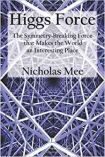Higgs Force by Nicholas Mee
| Higgs Force by Nicholas Mee | |
|
| |
| Category: Popular Science | |
| Reviewer: George Care | |
| Summary: A lucid explanation concerning the symmetry breaking force that makes the world an interesting place accompanied by excellent notes and a useful bibliography. | |
| Buy? Yes | Borrow? Yes |
| Pages: 33o | Date: January 2012 |
| Publisher: The Lutterworth Press | |
| External links: Author's website | |
| ISBN: 978-0718892753 | |
|
| |
Nicholas Mee, was a Senior Wrangler at Trinity College, Cambridge and having taken his PhD in Theoretical Particle Physics by submitting his thesis on Supersymmetric Quantum Mechanics and Geometry, he is uniquely qualified to explain the mysteries of the Higgs force. He is also a fellow of the Royal Astronomical Society. Whereas other texts rapidly resort to references to erudite constructs like 'non-zero expectation values', 'zz Dibosons' and 'Bose-Einstein statistics', Dr Mee provides an accurate account of the Geneva experiments with the Large Hadron Collider, provides his readers with some insight into the character of eminent physicists, and furnishes a lucid account of current theories. Included is an exposition of the discovery of elements by Sir Humphry Davy to recent experiments to discover Peter Higg's elusive particle.
Higg's cleverly adapted the musings of the Soviet physicist from Azerbaijan, Lev Davidovich Landau, (although imprisoned, the latter narrowly escaped the full force of a Stalin's purge) in order to explain and establish the so-called Standard Model of particle physics. The Higgs boson lies at the heart of the fundamental question of why there is mass in the universe. It seems that this has probably now been found by two independent experiments around the 13th December last year. If this is correct, then it establishes that there is an invisible energy field that fills the vacuum throughout known space-time.
Most books introducing the complexities of particle physics inevitably have a somewhat steep learning curve. Dr Mee handles this by dispensing, as far as possible, with complex mathematics and makes excellent use of interesting diagrams. He also inserts some problems for readers that prompt engagement in the text. These are good for the brain and make it a most suitable text for sixth formers and first year undergraduates.
The first third of Higgs Force is an introduction to basic atomic theory, symmetry, and the creation of elements during the evolution of stars. Our bodies, containing carbon, oxygen and hydrogen, amongst other elements, were formed in nuclear reactions in the high temperatures in stellar interiors. We are all literally composed of this star dust.
Our knowledge of the conditions in stars is largely derived from the study of spectra from the light emitted from them. This 'barcode' is explained in terms of the theory of quantum mechanics. This theory was developed by Bohr, Heisenberg and Erwin Schrödinger. Heisenberg's discovery of the Uncertainty Principle, and his putative work for the Nazis on the Bomb, and indeed his intense arguments with Bohr are featured in Michael Frayn's remarkable play, Copenhagen. Nicholas Mee, however, remarks how Heisenberg's matrix mechanics in the early 1930s could be proved equivalent to Schrödinger's wave mechanics and explains the 'barcode' spectra of the hydrogen atom and much else besides. In the next chapter on quantum electrodynamics (QED), Dr Mee shows how the weak interactions between electrons and virtual photons were independently explained by the complex mathematics of Julian Schwinger, on the tiny magnetic field of spinning electrons, and the more intuitive diagrams of his fellow New York scientist, the brilliant Richard Feynman. Two Englishmen also feature in this story, in a manner that retains human interest, the strange Paul Dirac from Bristol - his father was actually French - and the talented mathematician and eloquent expositor, Freeman Dyson. Thus the essential underlying concepts of this type of physics; symmetry, equivalence and symmetry breaking are all explained in an accessible manner.
Higg's Force neatly balances theory with an account of experimental techniques for creating high energy collisions and the resulting observed particles by means of detectors. There is a neat account of how neutrinos were originally discovered and the instrumentation then refined. The description of the injection of the initial protons into the Main Ring of the CERN accelerator captures the excitement of the very first experiments at Geneva, some 40 years ago now. Computer techniques for the sifting and analysis of experimental data are indicated and notably, the development by Sir Timothy Berners-Lee of what was to become the world-wide Web, doubtless the best known spin-off from the biggest internet node in Europe. The notable gigantic ATLAS detector with its hadron calorimeter and shielding is explained using cut-away diagrams.
Perhaps, the author might have added some magnificent coloured plates but this would have added considerably to the cost. Clear diagrams explain the patterns of the leptons, quarks and their respective anti-particles; these constitute the so-called Standard Model. The mechanism by which the Higgs particle breaks the symmetry of the electro-weak forces is indicated and the connection with the now famous Mexican hat diagram. A useful appendix which contains more algebra indicates the role the Higgs particle has in relation to the force field which is responsible for the creation of mass. Confirmation of this Higgs mechanism could be with us during this year and with it a more complete understanding of the earliest fraction of a second following the big bang.
Dr Mee has provided us with an exposition which repays close reading in the fine tradition of books like P.C.W. Davies, The Forces of Nature and Frank Close's classic on quarks, The Cosmic Onion. However, should it turn out that photons really do travel faster than light, then yet another scientific revolution may take place and the whole physics community will be back to ruminating on the shifting paradigms like Viktor Jakob, the proponent in that marvellous fictional account by Mccormack entitled, Night Thoughts of a Classical Physicist!
Many thanks are due to the Lutterworth Press for providing this volume for consideration.
For further reading we can also recommend:
Quantum: Einstein, Bohr and the Great Debate About the Nature of Reality by Manjit Kumar
Quantum Theory Cannot Hurt You by Marcus Chown
Gravity, Cracking the Cosmic Code by Nicholas Mee
Please share on: ![]() Facebook,
Facebook, ![]() Twitter and
Twitter and
![]() Instagram
Instagram
![]() You can read more book reviews or buy Higgs Force by Nicholas Mee at Amazon.co.uk Amazon currently charges £2.99 for standard delivery for orders under £20, over which delivery is free.
You can read more book reviews or buy Higgs Force by Nicholas Mee at Amazon.co.uk Amazon currently charges £2.99 for standard delivery for orders under £20, over which delivery is free.
![]() You can read more book reviews or buy Higgs Force by Nicholas Mee at Amazon.com.
You can read more book reviews or buy Higgs Force by Nicholas Mee at Amazon.com.
Comments
Like to comment on this review?
Just send us an email and we'll put the best up on the site.


